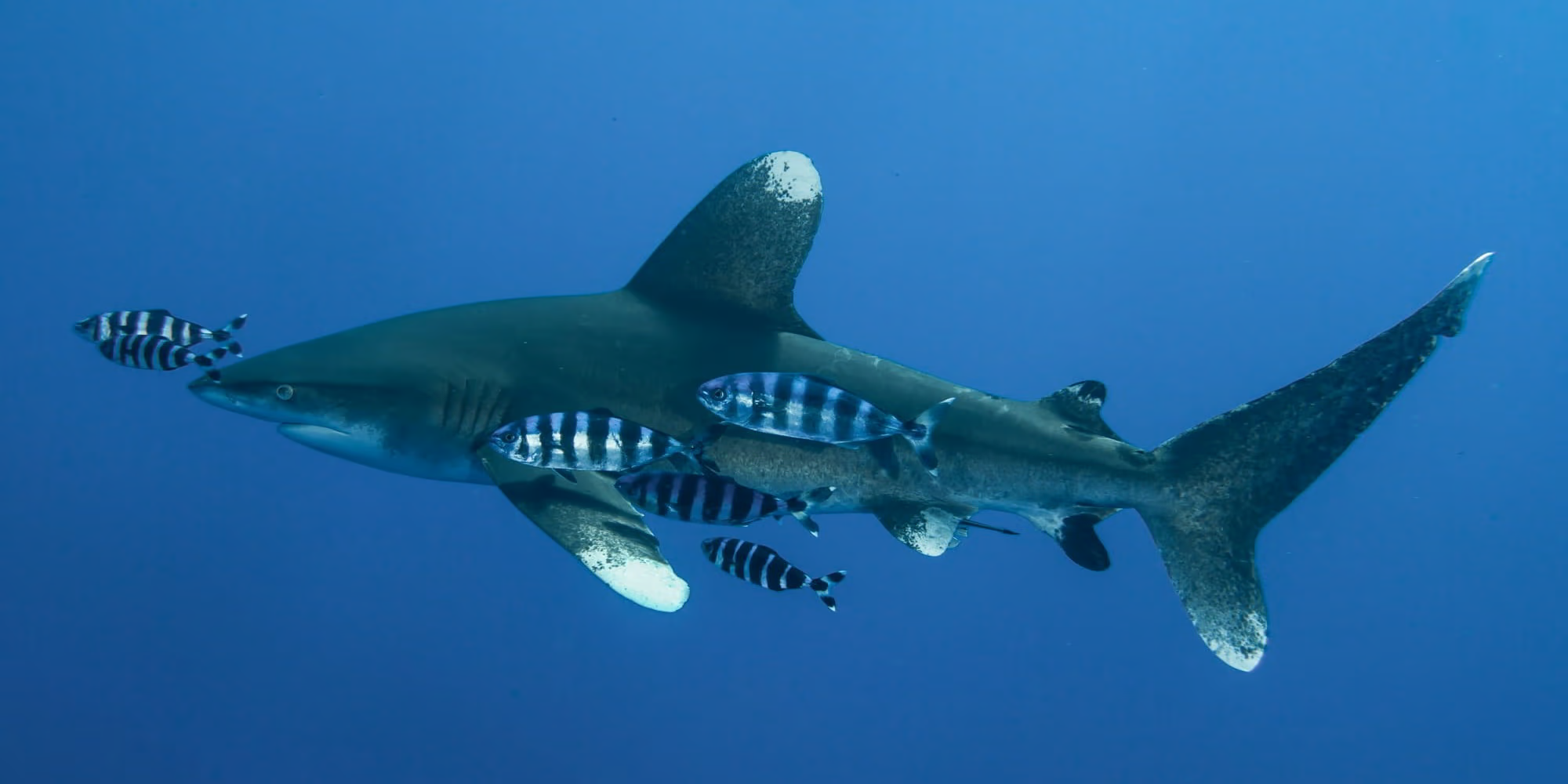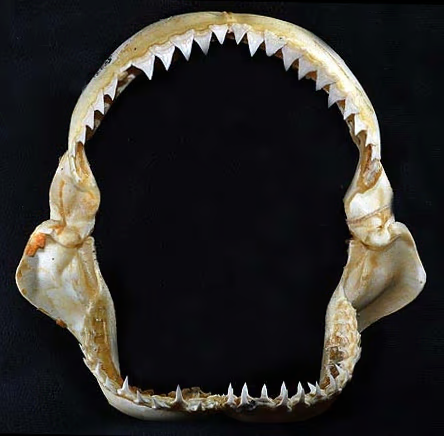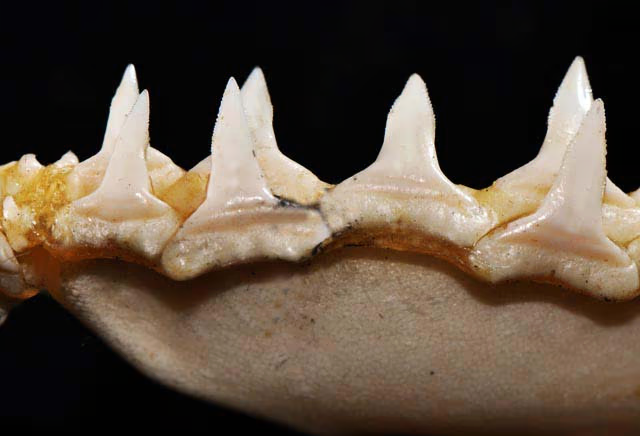The oceanic whitetip shark (Carcharhinus longimanus) impresses with its distinctive body shape and striking fins.
Body Structure, Characteristics & Anatomy
The oceanic whitetip shark, scientifically known as Carcharhinus longimanus, is one of the most striking inhabitants of the open ocean. With its characteristic long pectoral fins and the distinctive white tips that give it its name, it is easy to recognize. But behind this striking appearance lies a fascinating organism with numerous anatomical features. In this article, we take a detailed look at the body structure and the differences between the sexes of this shark species.
Body structure and size
The body of the oceanic whitetip shark is streamlined and powerfully built – perfectly adapted to life in the open sea. Adult individuals typically reach a length of between 2.5 and 3.5 meters. Some specimens can even grow up to four meters long. Depending on size and sex, their weight ranges between 50 and 170 kilograms.
Compared to other shark species, the body appears relatively bulky. Particularly striking are the very long, rounded pectoral fins, which give it a unique silhouette. The dorsal and caudal fins also appear disproportionately large in relation to the rest of the body.
Fins and naming
The oceanic whitetip shark gets its name from the striking white tips on its pectoral, dorsal, caudal, and pelvic fins. These white markings stand out clearly against the otherwise gray-brown to bronze-colored body. They are believed to serve as a means of communication among individuals of the same species and may help during hunting by confusing or startling prey.
The pectoral fins are not only long but also broad and sickle-shaped. Their function goes far beyond mere stabilization – they actively assist with turning maneuvers and enable energy-efficient gliding through the water.
Head and sensory organs
The head of the oceanic whitetip shark is broad and slightly flattened. The snout is rounded, with small, closely spaced nostrils. Also striking are the large, round eyes, which can adapt to the changing light conditions of the open ocean.
Like all sharks, this species also possesses a highly developed sensory arsenal. The so-called ampullae of Lorenzini – specialized receptors in the head region – allow it to detect electrical fields generated by muscle movements of potential prey. Its sense of smell is also extremely acute, enabling the shark to track blood trails over several kilometers.
Skin structure and coloration
The skin of the oceanic whitetip shark is covered with tiny, tooth-like scales called placoid scales. These give the skin a rough texture and reduce water resistance, allowing the animal to swim faster and more efficiently.
The base coloration varies between gray, bronze, and olive green, with the underside always being lighter. This so-called countershading effect helps the shark to camouflage better when viewed from both above and below in the water.
Differences between males and females
Although male and female whitetip reef sharks look very similar externally, some physical traits allow differentiation. Male sharks have claspers—paired reproductive organs on the pelvic fins. These are clearly visible and used for sperm transfer during mating.
Females, on the other hand, generally have a slightly greater body length, especially when fully grown. Studies show that female oceanic whitetip sharks are often more robustly built and have thicker skin – a possible protective mechanism against bite injuries from males during mating.
Distribution & Habitat
The oceanic whitetip shark is one of the most well-known inhabitants of the open ocean. Its distinctive white-tipped fins and graceful swimming style make it fascinating not only to marine biologists but also to divers and nature enthusiasts. But where exactly does this shark species live, and what factors influence its habitat? In this article, we take a close look at the geographic distribution and ecological requirements of Carcharhinus longimanus.
Worldwide distribution in tropical and subtropical waters
The oceanic whitetip shark is found almost worldwide in all tropical and subtropical marine regions. Its preferred habitat extends around the equator, ranging approximately from 30 degrees north to 30 degrees south latitude. It occurs in the Atlantic as well as in the Indian and Pacific Oceans.
Typical locations include the Caribbean, the Red Sea, the coasts of East Africa, the waters around Indonesia, and the central Pacific. The species is also regularly observed in the Gulf of Mexico and in the western Atlantic along the eastern coast of the United States.

A typical inhabitant of the open ocean
In contrast to many other shark species, the oceanic whitetip shark does not prefer shallow coastal waters but lives mainly in the open ocean. This so-called pelagic lifestyle means that it usually stays far from the mainland or coral reefs. It is often sighted at depths of up to 150 meters, although it prefers the upper water layers between 0 and 70 meters.
Especially in regions with pronounced temperature differences between water and air layers, the shark is often found near the surface. There, it benefits from the abundance of prey such as squid, flying fish, and other schooling fish.
Temperature and oxygen requirements
As a heat-loving species, the oceanic whitetip shark prefers water temperatures between 20 and 28 degrees Celsius. It is rarely found in colder waters. Its activity is closely linked to the surrounding temperature, as its metabolism, being ectothermic, is highly temperature-dependent.
The oxygen content of the water also plays an important role in its habitat. In low-oxygen zones, such as those found in certain deep-sea areas, the species is rarely present. Instead, it prefers well-mixed water layers with sufficient oxygen levels.
Migration behavior and orientation
The oceanic whitetip shark is considered more stationary than many other open-ocean sharks. Although it does undertake longer journeys in search of food, long-term seasonal migrations like those of other species have rarely been documented. Many individuals appear to remain in certain ocean regions for extended periods.
For orientation, the shark uses a combination of different senses. Magnetoreception, temperature gradients, currents, and chemical signals in the water help it navigate over long distances. Despite the apparent vastness of its habitat, it knows its structure and dynamics surprisingly well.
Influence of environmental changes
Like many pelagic species, the oceanic whitetip shark is sensitive to changes in the marine ecosystem. Rising water temperatures, overfishing, and increasing ocean pollution are increasingly affecting its habitat. In some regions, declines in sighting numbers have been observed over recent decades, which can be attributed to changing environmental conditions and human impacts.
In particular, commercial deep-sea fishing, where the shark is often caught as bycatch in fishing nets, has greatly reduced its populations in many areas. The loss of large contiguous habitats and the disruption of its movement patterns can have serious long-term effects on the species.
Master of adaptation in the open seas
The oceanic whitetip shark is a fascinating example of adaptation to life in the open sea. Its distribution spans vast parts of the world’s oceans, yet its ecological niche is clearly defined. The combination of tropical temperatures, oxygen-rich water layers, and open space makes the ocean its ideal home. However, this very habitat is increasingly threatened today. To ensure the long-term preservation of this impressive shark species, a better understanding of its lifestyle and ecological needs is essential.
Lifestyle, diet & reproduction
The oceanic whitetip shark is considered one of the most charismatic inhabitants of the open seas. With its striking appearance and calm but determined swimming style, it attracts not only the attention of researchers but also fascinates divers worldwide. In this article, we take a closer look at its lifestyle, hunting strategies, and reproduction of this extraordinary shark species.
Behavior in the open sea
The oceanic whitetip shark prefers to live in the open ocean, far from coastal regions and coral reefs. There, it usually moves calmly through the upper water layers. Its behavior is considered curious and, in certain situations, even aggressive, especially when food sources are nearby.
Although often described as a solitary animal, smaller groups occasionally form in the wild, especially when abundant food is available. This leads to a noticeable social dynamic where dominance behavior and competition for food play a role. In such moments, the usually slow-moving shark can appear surprisingly agile and assertive.
Hunting behavior and diet
The oceanic whitetip shark is an opportunistic hunter. This means it takes every opportunity to find food and adapts its hunting strategy flexibly to the prevailing conditions. It mainly feeds on bony fishes, squids, flying fishes, and crustaceans. Occasionally, it also consumes carrion or preys on smaller sharks and rays.
Its long pectoral fins enable it to glide efficiently through the water, allowing it to cover great distances with little energy. During hunting, it uses its excellent senses: besides the sense of smell and the ability to detect electric fields, its eyesight is also important for locating prey.
In areas with high prey density—such as around drifting fish schools or whale fall sites—the shark can become very active and competitive. It then also shows a pronounced snapping behavior, where it deliberately strikes at moving objects.
Reproduction: live-bearing strategy
Like many species of the genus Carcharhinus are live-bearing? The oceanic whitetip shark is live-bearing. This means the embryos develop inside the mother's body and are born fully developed. This reproductive strategy is called viviparous and is widespread among sharks.
The gestation period lasts about nine to twelve months. During this time, the embryos are supplied with nutrients via a yolk-sac placenta—a form of nourishment functionally similar to the placenta in mammals. At the end of the gestation period, the female usually gives birth to between one and five pups. These are already over half a meter long at birth and fully independent.
Reproduction is not seasonally bound but depends on the individual living conditions of the animals. Males have so-called claspers—paired mating organs on the pelvic fins—with which they fertilize the female during mating. The behavior during mating can be rough and is often accompanied by bite marks, which is why females have significantly thicker skin than males.
Growth and survival chances of the young
The young of the oceanic whitetip shark are well developed at birth but vulnerable to predators such as larger sharks or tunas. They grow relatively slowly and reach sexual maturity only at about six to eight years. The average lifespan is around 15 years but can exceed this under natural conditions.
Since the species reproduces slowly and produces few offspring per litter, it is particularly vulnerable to population declines. The loss of any sexually mature individual directly affects the stability of the population.
An adaptable hunter with sensitive reproduction
The oceanic whitetip shark is perfectly adapted to life in the open sea. With its flexible hunting strategy, social behavior, and sophisticated reproduction, it is one of the most fascinating species of the pelagic ecosystem. At the same time, its slow reproduction rate makes it vulnerable to environmental changes and human impact. Anyone who learns more about this shark quickly realizes how important the protection of this unique species is for the balance of the ocean.
Humans & oceanic whitetip sharks
In popular diving areas such as the Red Sea or parts of the Indo-Pacific, the oceanic whitetip shark is increasingly deliberately sought out. It is considered relatively easy to observe, as it often patrols near the surface and rarely seems disturbed by divers. Unlike many shark species, it does not flee immediately but approaches calmly and with curiosity. This curious nature makes it a highlight for many divers – but at the same time, it also carries a certain risk.
The shark is not an aggressive hunter that targets humans, but it investigates everything that could be potential prey. This includes unfamiliar shapes in the water, shiny equipment, or isolated swimmers. It swims slowly closer, often stays nearby, and occasionally tests with cautious bites – a behavior that can seem unsettling underwater but usually does not pose an immediate danger.
When Curiosity Becomes Danger: Documented Incidents
In the history of modern diving and seafaring, there are a number of documented incidents in which the oceanic whitetip shark was involved in critical situations. Its behavior towards shipwreck survivors is particularly well known. During World War II, survivors of torpedo attacks in the Pacific repeatedly reported shark attacks – many of which were attributed to the oceanic whitetip shark.
These scenarios have a simple explanation: Shipwreck survivors often drift motionless on the water surface for hours or days – exactly in the habitat where this shark hunts. In the absence of other prey, it instinctively reacts to the unusual presence. In such exceptional cases, aggressive behavior can occur, triggered by hunger, stress, and territoriality.
In recent times, isolated incidents involving snorkelers and divers have been reported. These are often linked to feedings, so-called "shark feeds," which habituate the animals to humans and alter their natural behavior. If a white-tip oceanic shark is conditioned by repeated feeding, it can increasingly associate humans with food sources – a dangerous mechanism.
Typical Behavior During Interaction With Humans
The white-tip oceanic shark displays a number of clearly recognizable behavioral patterns when encountering humans. It moves slowly and deliberately, circles widely, and often approaches multiple times. It probes with its fins and snout but usually remains calm. In rare cases, behavior can change abruptly—for example, if a diver reacts panic-stricken or swims hastily to the surface. Then the animal may temporarily switch to a more active, assertive pattern.
It is important to understand: The shark is not a "hunter of humans." Rather, it tries to identify potential objects – cautiously testing the boundary between curiosity and hunting behavior. Depending on experience, situation, and environment, this boundary can be crossed more or less quickly.
Respect and Caution – No Room for Panic
Experts advise staying calm and controlled during encounters with the white-tip ocean shark. Maintaining clear eye contact, avoiding sudden movements, and holding one’s position in the water help prevent misunderstandings. It is especially important never to dive alone and not to drift at the surface when a shark is visible.
Targeted feeding should be avoided. It may produce spectacular images but can negatively impact the shark's natural behavior in the long term. Tour operators and divers should focus on observation from a respectful distance—a safer and more sustainable practice for all involved.
Fascination with responsibility
The white-tip ocean shark is an impressive inhabitant of the open sea, whose behavior toward humans ranges from cautious curiosity to potential danger. Underwater encounters can be unforgettable—if they occur with the necessary respect and understanding. As a diver or observer, one should be aware that they are meeting the shark in its natural habitat. Approaching this experience with care allows one to appreciate the beauty of this species—without putting it or oneself at risk.
Threats & Population Development
Hardly any other shark species has experienced such a dramatic decline in recent decades as the oceanic whitetip shark. Even in the mid-20th century, it was one of the most common pelagic sharks in the tropical oceans. Today, Carcharhinus longimanus is classified as "critically endangered" by the International Union for Conservation of Nature (IUCN). But what are the causes behind this dramatic decline? What is the current status of its populations? And which measures could help stop the decline? This article sheds light on the threat status and the development of this impressive shark species.
A Decline of Alarming Proportions
Scientific studies and observations suggest that populations of the oceanic whitetip shark have declined worldwide by up to 90 percent— in some regions even by more than 98 percent. The western Atlantic is particularly affected, where the species once occurred in large numbers. Today, it is considered rare there. The shark is also now seen only sporadically in the Pacific and Indian Oceans.
This decline is all the more alarming because the oceanic whitetip shark plays a crucial role in the marine food web. As a top predator, it regulates the balance of ocean ecosystems. Its disappearance would have far-reaching consequences for biodiversity and the ecological balance in the open sea.
Causes of the Threat
The main cause of the drastic decline in populations is commercial fishing. The oceanic whitetip shark is targeted in many regions around the world or killed as bycatch in tuna and swordfish fleets. Its large pectoral fins are especially sought after in the international fin trade. In some markets, they fetch high prices, making it an attractive target for fishermen.
Additionally, the shark’s curious nature makes it easy to catch. It approaches boats and bait without much hesitation—a behavior that makes it vulnerable to targeted fishing operations. Illegal fishing methods and unregulated fishing zones also contribute to the decline.
Biological Weaknesses as a Risk Factor
Like many other shark species, the oceanic whitetip shark reproduces slowly. Females give birth to only a few pups after a long gestation period of up to twelve months. This low reproductive rate makes it nearly impossible for the species to quickly recover from massive losses.
In addition, the animals only reach sexual maturity after several years. A significant loss of sexually mature females therefore has an immediate and long-term impact on the regeneration of populations. This biological disadvantage, combined with human pressure, greatly increases the risk of extinction.
Protection measures and international classification
Due to the dramatic decline, the oceanic whitetip shark was classified as "Critically Endangered" by the IUCN in 2019. This is the highest threat category before extinction in the wild. The species has also been included in international conservation agreements. For example, it is listed in Appendix II of the Washington Convention on International Trade in Endangered Species (CITES), which strongly regulates its international trade.
Some countries have already introduced national fishing bans or established protected areas. In certain fishing zones, regulations apply to reduce bycatch rates. These include, for example, the use of special hooks or the deployment of observers on board fishing vessels. Nevertheless, such measures often remain incomplete or difficult to enforce—especially in international waters.
Research and Public Awareness
Another important component in the protection of the oceanic whitetip shark is scientific research. Through satellite telemetry, genetic studies, and observational data, researchers try to better understand the behavior and migration patterns of this shark species. These insights are crucial for developing effective conservation measures and adjusting existing regulations.
Public education also plays an important role. Many people are unaware of how severely threatened this shark species is and how central its role is in the ecosystem. Films, documentaries, and educational initiatives can help raise awareness and increase societal pressure on politics and fisheries.
Time to Act
The Oceanic Whitetip Shark is a symbol of the silent crisis in the world’s oceans. Its dramatic decline is not an isolated case but a sign of a deeper problem: the overexploitation of the open seas. To preserve this fascinating pelagic predator for future generations, binding international protection regulations, sustainable fisheries policies, and increased public awareness are needed. It is not too late yet — but the window of opportunity is closing.










